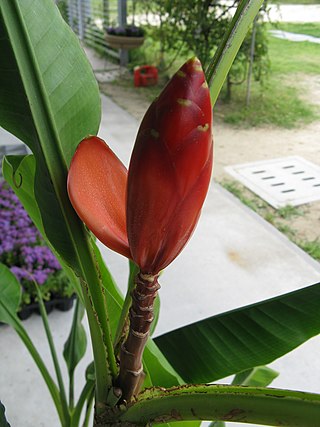
A banana is an elongated, edible fruit – botanically a berry – produced by several kinds of large herbaceous flowering plants in the genus Musa. In some countries, bananas used for cooking may be called "plantains", distinguishing them from dessert bananas. The fruit is variable in size, color, and firmness, but is usually elongated and curved, with soft flesh rich in starch covered with a rind, which may be green, yellow, red, purple, or brown when ripe. The fruits grow upward in clusters near the top of the plant. Almost all modern edible seedless (parthenocarp) bananas come from two wild species – Musa acuminata and Musa balbisiana. The scientific names of most cultivated bananas are Musa acuminata, Musa balbisiana, and Musa × paradisiaca for the hybrid Musa acuminata × M. balbisiana, depending on their genomic constitution. The old scientific name for this hybrid, Musa sapientum, is no longer used.

Musaceae is a family of flowering plants composed of three genera with about 91 known species, placed in the order Zingiberales. The family is native to the tropics of Africa and Asia. The plants have a large herbaceous growth habit with leaves with overlapping basal sheaths that form a pseudostem making some members appear to be woody trees. In most treatments, the family has three genera, Musa, Musella and Ensete. Cultivated bananas are commercially important members of the family, and many others are grown as ornamental plants.

Ensete is a genus of monocarpic flowering plants native to tropical regions of Africa and Asia. It is one of the three genera in the banana family, Musaceae, and includes the false banana or enset, an economically important food crop in Ethiopia.

Musa is one of three genera in the family Musaceae. The genus includes 83 species of flowering plants producing edible bananas and plantains. Though they grow as high as trees, banana and plantain plants are not woody and their apparent "stem" is made up of the bases of the huge leaf stalks. Thus, they are technically gigantic herbaceous plants. Musa species are used as food plants by the larvae of some Lepidoptera species, including the giant leopard moth and other Hypercompe species, including H. albescens, H. eridanus, and H. icasia.
The plant species Musa ingens, also known as the giant highland banana or Oem, is the physically largest member of the family Musaceae and the only member of the section Ingentimusa. Growing in the tropical montane forests of New Guinea - Arfak Mountains Regency in Indonesia, its leaves can reach a length of 5 meters and a width of 1 m. This, the largest herbaceous plant on earth, was completely unknown to science prior to 1960.

Musa basjoo, known variously as Japanese banana, Japanese fibre banana or hardy banana, is a species of flowering plant belonging to the banana family Musaceae. It was previously thought to have originated in the Ryukyu islands of southern Japan, from where it was first described in cultivation, but is now known to have originated in subtropical southern China, where it is also widely cultivated, with wild populations found in Sichuan province. Its specific name is derived from its Japanese common name, bashō (芭蕉).
Musa maclayi is a species of seeded banana native to Papua New Guinea and the Solomon Islands. It is placed in section Callimusa. It is regarded as one of the progenitors of the Fe'i banana cultivars.

Musa itinerans, the Yunnan banana, is a species of banana found in continental Southeast Asia from Northeast India to Vietnam. The tender inner stalk is also harvested and eaten. It is the landmark 24,200th plant species saved at Kew Gardens' Millennium Seed Bank Project. With this addition, the seed bank had collected 10% of the world’s wild plant species. In China it is an important food for wild Asian elephants.
Musa salaccensis, commonly called Javanese wild banana, is a Malesian tropical species of plant in the banana family native to the islands of Sumatra and Java, in Indonesia. It is placed in section Callimusa, members of which have a diploid chromosome number of 2n = 20.

Fe'i bananas are cultivated plants in the genus Musa, used mainly for their fruit. Unlike most other cultivated bananas they are diploids of the AA-type. They are very distinct in appearance and origin from the majority of bananas and plantains currently grown. Found mainly in the islands of the Pacific, particularly French Polynesia, Fe'i bananas have skins which are brilliant orange to red in colour with yellow or orange flesh inside. They are usually eaten cooked and have been an important food for Pacific Islanders, moving with them as they migrated across the ocean. Most are high in beta-carotene.

Markku Häkkinen was a Finnish self-taught botanist, considered one of the world's leading experts on the taxonomy of bananas. Forty-six out of the seventy known species of wild bananas have been described by Häkkinen. The Linnean Society of London awarded him the H. H. Bloomer Award of 2009. In 2015 Häkkinen received the Finnish Cultural Foundation's Award for outstanding cultural achievement.

Ernest Entwistle Cheesman, was an English botanist noted for his work on the family Musaceae. He was the son of Charles Cheesman and Grace Lizzie Davies. About August 1936 he married Ellen Elizabeth B. Weston (1892-1966).

Musa beccarii is a species of wild banana, found in Malaysia, in Sabah. It is placed in section Callimusa.

Musa jackeyi is a species of wild banana in the Banana Family (Musaceae).. It is placed in section Callimusa. It has only a small native range in north-east Queensland, Australia. It is the second tallest banana species after Musa ingens, having petioles (stalks) up to 33 ft (10 m) in height, topped by laminae (blades) 14.5 ft (4.4 m) long by 2 ft (61 cm) in width, for a total height of up to 47.5 ft (14.5 m). It resembles the cultivated bananas called "fe'i" or "fehi", having an upright rather than a drooping fruit stalk, with the green terminal bud pointing upwards, and sap which is reddish in colour.
Musa boman is a species of wild banana, native to the West Sepik (Sandaun) Province of Papua New Guinea, in the eastern portion of the island of New Guinea. It is placed in section Callimusa, having a diploid chromosome number of 2n = 20. The male bud is cream in colour.
Musa fitzalanii is a species of wild banana, which was native to north-east Queensland, Australia, but is now believed to be extinct. The type specimen was collected in the 19th century, from the vicinity of 'Daintree's River' most likely by Eugene Fitzalan, an Irish collector who apparently worked with Ferdinand von Mueller, the first describer of the species. Along with M. acuminata and M. jackeyi, it was one of the three species native to Australia. It was placed in section Callimusa.
Musa lawitiensis is a species of wild banana, native to the island of Borneo. It is placed in section Callimusa, having a diploid chromosome number of 2n = 20.

Musa lolodensis is a species of wild banana, occurring naturally from the Moluccas through to New Guinea. It is placed in section Callimusa, having a diploid chromosome number of 2n = 20. It is one of the possible parents of the cultivated Fe'i bananas.
Musa monticola, also known as the Kinabalu mountain banana, is a species of wild banana, native to Sabah on the island of Borneo. It is placed in section Callimusa, having a diploid chromosome number of 2n = 20.
Musa arunachalensis is a species in the genus Musa. It was first described in 2013 by botanists from the University of Calicut in Kerala.











